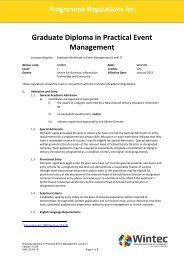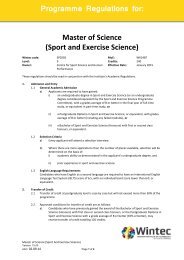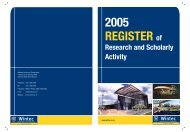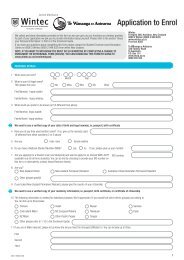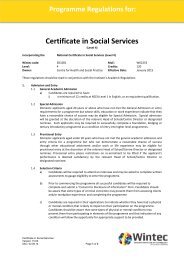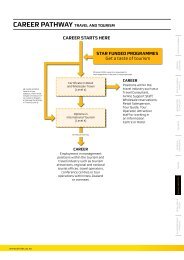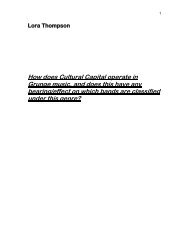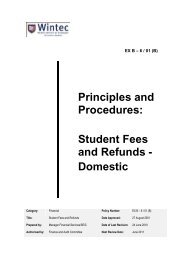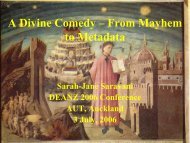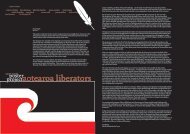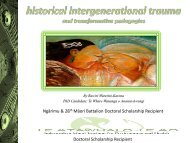2012 wintec annual report
2012 wintec annual report
2012 wintec annual report
Create successful ePaper yourself
Turn your PDF publications into a flip-book with our unique Google optimized e-Paper software.
WINTEC ANNUAL<br />
REPORT <strong>2012</strong><br />
49<br />
is recognised to the extent that absences in the coming year are<br />
expected to be greater than the sick leave entitlements earned in<br />
the coming year. The amount is calculated based on the unused<br />
sick leave entitlement that can be carried forward at balance date;<br />
to the extent it will be used by staff to cover those future absences.<br />
A liability and an expense are recognised for bonuses and at risk<br />
components where contractually obliged or where there is a past<br />
practice that has created a constructive obligation.<br />
Long-term employee entitlements<br />
Employee benefits that are due to be settled beyond 12 months after<br />
the end of the period in which the employee renders the related<br />
service, such as long service leave and retirement gratuities, have<br />
been calculated on an actuarial basis. The calculations are based<br />
on: likely future entitlements accruing to staff, based on years of<br />
service, years to entitlement, the likelihood that staff will reach the<br />
point of entitlement, and contractual entitlement information; and<br />
the present value of the estimated future cash flows.<br />
Presentation of employee entitlements<br />
Sick leave, <strong>annual</strong> leave, vested long service leave, and non-vested<br />
long service leave and retirement gratuities expected to be settled<br />
within 12 months of the balance date, are classified as a current<br />
liability. All other employee entitlements are classified as a noncurrent<br />
liability.<br />
Superannuation schemes<br />
Defined contribution schemes<br />
Obligations for contributions to KiwiSaver, the government<br />
superannuation fund, and other defined contribution<br />
superannuation schemes are recognised as an expense in the<br />
surplus or deficit as incurred.<br />
Provisions<br />
A provision is recognised for future expenditure of uncertain<br />
amount or timing when there is a present obligation (either legal<br />
or constructive) as a result of a past event, it is probable that an<br />
outflow of future economic benefits will be required to settle the<br />
obligation, and a reliable estimate can be made of the amount of<br />
the obligation.<br />
Provisions are measured at the present value of the expenditures<br />
expected to be required to settle the obligation using a pre-tax<br />
discount rate that reflects current market assessments of the<br />
time value of money and the risks specific to the obligation. The<br />
increase in the provision due to the passage of time is recognised<br />
as an interest expense and is included in “finance costs”.<br />
Equity<br />
Equity is measured as the difference between total assets and<br />
total liabilities. Equity is disaggregated and classified into a<br />
number of components. The components of equity are:<br />
• general funds;<br />
• property revaluation reserve; and<br />
• restricted reserves.<br />
Property revaluation reserves<br />
This reserve relates to the revaluation of property, plant,<br />
and equipment to fair value.<br />
Restricted reserves<br />
Restricted reserves are a component of equity generally<br />
representing a particular use to which various parts of equity have<br />
been assigned. Reserves may be legally restricted or created by<br />
the Institute. Transfers from these reserves may be made only for<br />
certain specified purposes or when certain specified conditions<br />
are met.<br />
Goods and services tax<br />
All items in the financial statements are stated exclusive of goods<br />
and services tax (GST), except for debtors and other receivables<br />
and creditors and other payables, which are presented on a GST –<br />
inclusive basis. Where GST is not recoverable as input tax then it is<br />
recognised as part of the related asset or expense.<br />
The net amount of GST recoverable from, or payable to, the Inland<br />
Revenue Department (IRD) is included as part of receivables or<br />
payables in the statement of financial position.<br />
The net GST paid to, or received from the IRD, including the GST<br />
relating to investing and financing activities, is classified as a net<br />
operating cash flow in the statement of cash flows.<br />
Commitments and contingencies are disclosed exclusive of GST.<br />
Income tax<br />
The Institute and the Wintec Foundation is exempt from income<br />
tax, all other entities in the Group are liable for tax.<br />
FINANCIAL PERFORMANCE<br />
1<br />
2<br />
3<br />
4<br />
5<br />
6<br />
7<br />
8<br />
9<br />
10



